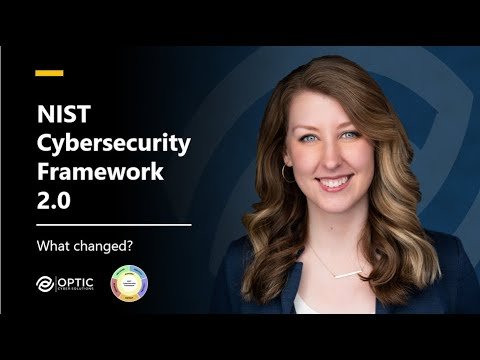The final update to the NIST Cybersecurity Framework 2.0 is here! Check out this video to learn about what changed and where to dig in!
Presented by Kelly Hood, CISSP (@KellyHood_)
Optic Cyber Solutions strives to help organizations identify and address their blind spots through our assessment, implementation, and advising services. For more information about Optic Cyber Solutions and how we can help you integrate the CSF update or conduct a CSF gap assessment, reach out at Info@OpticCyber.com or check out our website at
Video: Overview – NIST Cybersecurity Framework 2.0
Video: Profiles – NIST Cybersecurity Framework 2.0
Video: Do I Measure Up? NIST Cybersecurity Framework 2.0
CSF 2.0 Maturity & Progress Tracker (MaPT):
CSF 2.0 Profile Template:
The NIST Cybersecurity Framework (CSF) 2.0:
Quick Start Guides:
CSF 2.0 Profiles:
Informative References:
Cybersecurity & Privacy Reference Tool (CPRT):
CSF 2.0 Reference Tool:
CSF 2.0 Website:
CForum Community:

Well done – thanks…
Dear Presenter,
Thank you for your support,
when a device remained compromised for long,
Few issues start occurring:
1. Information that device has or sends/receives, can be accessed by just any.
2. As a result, No information is secured, as a result of, on the next day, anyone can claim as such, For instance, 2.0 is a marking word for this outline, what if tomorrow someone creating content using 2.0, for compromised device, its not possible to find out , a genuine provider or imposter.
3. It is also impossible, to know who is actual provider.
so, Any chance, a few basic information can be obtained to know what’s going on…
As it’s been a while, this cybersecurity giving such a confusing impression which information to believe and which one to ignore!
plus few other uncertainty makes it failed project since beginning, Time, Energy & Money is spent but no development so far!
It’s actually frustrating for the device as if anything could be done to educate the device into more secure way, Output may occur quicker than expected.
Or any other method or advice, that You like to share for students please?
Kind regards,
Thanks for your video. Excited to start using the 2.0 Version of the NIST Cybersecurity Framework. 😉
How this "Farmework" have to do with using ISA/IEC 62443 standards to secure ICS?
Very well explained 🎉
Lol, what a luck I have today , that I find You. You explain this very well. In my life upgrade I was not wishing any more than Your YT Video. Fantastic.. 🙂
Thanks for the breakdown. The MaPT can't be downloaded. It redirects to Hubspot, requiring the administrator's login. I would to see that template.
Presented in a really nice way. Great job
thank you for providing a great 'bridge' between v1.1 -> v2.0 – very helpful
Great Content , Thanks for the details. Could you please recommend from where to do NIST certification? Thanks
What type of appliance is commonly used for NIST cybersecurity?
Thank you Kelly!
Thank you 🙏🏻
Is NIST CSF v1.1 retired now?
Thanks for taking the time to break this down and provide details of changes
Wonderful video congrats
Thank you Kelly for this helpful summary on NIST CSF 2.0!
Many thanks for you sharing 😀
Love the videos. They have all been very helpful and no nonsense, just straight to the point and informative! Thank you!
This Video explains the Changes to the Framework. 13:20 is basically all you need to know
Thanks for the great and significant explanation on the frameworks differences.
Thanks Kelly, can you share slide ?
Hey,
Quick question.
If we have NIST CSF implemented in the organization then do we need to implement Govern as well or its not mandatory and needed?
Great and concise explanation Kelly. Congrats and thanks for sharing!
Are there subcategories that carry overt from 1.0? For example, in every list they've published, under Identify's Risk assessment it goes ID.RA-01, 02, 03, 04, and 05 then skips to ID.RA-07. Does this mean that the ID.RA-06 remains unchanged?
glad this video popped up in my algo. I am taking the CISSP in two weeks. very helpful.
❤
great review Kelly